Introduction of IT Systems
Company Background
Sports-Qits is a small company engaged in the manufacture of replica sports kits. The company was started by four college students nearly 10 years ago. The company has 20 staff (15 full-time and 5 part-time) spread through administrative, marketing, and personnel departments. Its customers are mostly small shops who give work orders to the company, mainly by telephone and through the post. The calls are answered by four staff belonging to the administrative department (not the marketing department). The administrative department is also in charge of finance. It takes care of billing, payroll, and accounts.
The marketing is done by the marketing department mainly through advertisements in trade publications and distribution of product leaflets to existing and potential customers. The company faced several problems like delayed and wrong deliveries, damaged goods, etc. Another problem was that customer payment were often delayed by up to six months. There were also complaints that the company could be contacted only during office hours and that product catalog and order placing facility exists only by post or contacting the company directly. All the above problems were mainly because Sport-Qits did not do business online, while its competitors had such facilities. The company has decided to introduce IT into its business for solving the operational problems currently faced by the company. This is the report for the implementation of such a system with recommendations for the required hardware and software.
Vision
To be the market leader in the replica sports kit manufacturing business and to be the best-valued company in terms of customer satisfaction.
Mission
To regain market share and lost goodwill through the introduction of new technology and to provide problem-free service to existing and new customers.
New system vs. old system
There is going to be a marked difference when comparing the old and new systems. The company uses IT for internal purposes only through a local area network mainly for routine tasks using spreadsheet and word processing software. The new system involves the design of the company website from scratch. It will also incorporate the existing computer network into the new system, with hardware up-gradation wherever necessary. New software that facilitates online order placing will be incorporated with existing software. Communication through email directly from the company website will be made available. All the above facilities will be through a very user-friendly interface at both ends.
New Organization chart of Sports-Qits (after integration of IT systems)
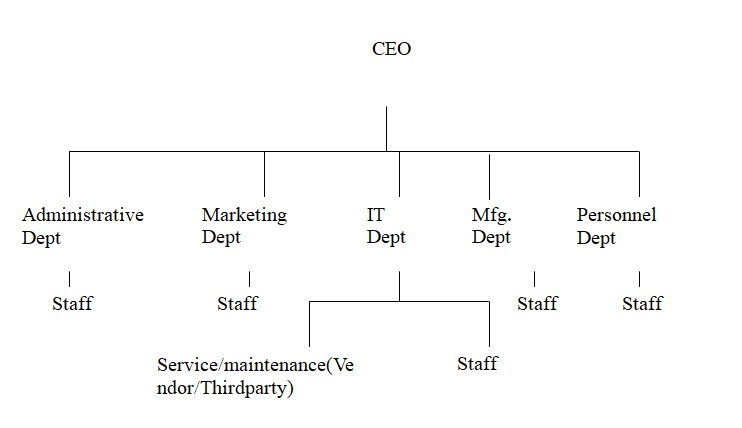
Constraints
The software and the website have the following constraints mainly due to the budget limitations of the company. But it has been designed in such a way that these constraints can be rectified at a later date.
- All online activities like email, ordering, and payment can be accessed at one node only. This means that the person in charge of that node has to notify other concerned departments manually or through its local area network about the activity.
- Similarly, all communication from the company to the customers and suppliers has to follow the same route, i.e. through the person in charge of the node.
- None of the staff have previous experience of e-commerce and have to be trained for the same.
- All payments by customers can only be done at present using credit cards. The use of debit cards and other internet banking options is not possible.
Benefits to stakeholders
- Customers: Online communication with the company is available 24×7. Ordering for sports kits can be done online even though finalization may take a few rounds of negotiations through e-mail. Once terms and processes are agreed upon, online payment facilities are also available. Online product price lists and catalogs are available along with a facility to register complaints.
- Employees: The smoother flow of communication and less paperwork. Employees can now receive communication that has been sent outside of office hours. Learning of new technology can be considered to be an added qualification when looking for employment elsewhere.
- Owner: Smooth flow of communication is possible. Optimal use of employees by transferring excess staff in the administrative department to the marketing department resulting in costs savings. The main and the most obvious benefit is better customer relations.
- Community: 24×7 facilities for communication with the company for viewing prices, ordering, payment, and registering complaints if any.
Cost of Project
Since operations are all small just one system needs to be bought at present. The company can use the existing systems and can purchase additional hardware as and when required.
The company need only buy a single PC suitable for home and small offices. Additional costs of developing software and design of the company website will have to be incurred. Staffing requirements can be accommodated by giving training to existing staff and only the IT Department head need be hired at present.
Total Cost for the year
- Hardware: $ 700
- Software: $ 1000
- IT Head: $ 12,000 (Salary for the year).
- TOTAL: $ 13,700
Hardware Specifications
HP dx2250 RT949UT AMD Desktop Computer:
- Processor: AMD 64 X2 4000.
- Speed: 2.0GHz dual-core.
- Memory: 2GB of DDR2 memory.
- Hard Disk: 80 GB.
- Drives: DVD-ROM/CD-RW optical drive.
- Monitor: HP w2207 22″ Widescreen Flat Panel Monitor with Bright View Panel.
- Operating System: MS Windows XP Professional.
- (HP dx2250 RT949UT AMD Desktop Computer. 2008).
Soft Systems Methodology
Systems Theory
Early systems of management formulated by the likes of F W Taylor were felt to be inadequate as organizations grew and became more complex. During the times of Taylor, the focus was on improving productivity and the only human approach considered was giving more wages to workers. This led to the way informing of the systems approach to management. Organizations are considered to be open systems where external factors too can influence their growth and survival.
The 1940s saw the development of a new approach to management and was called the systems approach to management. This approach was first developed by Ludvig Von Bertalanffy, called The General Systems Theory’ and was presented to the world in his book bearing the same name. Shortcomings in earlier theories of systems approach led to the formation of ‘The Systems of Systems Management (SOSM)’ by Michael C Jackson and Paul Keys at a University of Hull research program in 1984 and were published in the book titled ‘System Approaches to Management’.
Soft Systems Methodology
Soft Systems Methodology was developed by Peter Check land and is a systems approach that is used where the human element is present and it is this system that is being used to analyze and solve the problems in Sports-Qits. It is apparent from the case history that introducing information technology in the company has raised fears among its employees of losing their jobs and for learning new skills. It is clear from this that the emotions of employees are involved and hence the presence of human elements in the problem. The following steps are used in problem-solving using Soft System Methodology.
- The problem is investigated.
- Visually express the problem through Rich Pictures. A rich picture is a visual representation of all relevant information.
- Formulate root definitions. These are ways in which a problem is viewed from a different perspective or angle. There are six components in a root definition and are referred to as CATWOE. Customers, Actors, Transformation process, World view, Owner and Environmental concerns).
- Customers comprise all people deriving a benefit or disadvantage from the s system. So employees and owners of the company are also included here.
- Actors: Anyone who works in the system are referred to as an actor.
- Transformation process: The process of transforming raw materials to finished goods.
- Worldview implies as to what the company is, viewed by outsiders.
- Owner.
- Environmental constraints.
- Forming conceptual models.
- Comparison of Conceptual models and Real Picture.
- Possible design Changes.
- The required action is based on recommendations.
“The Soft Systems Methodology (SSM) from Peter Check land is a qualitative technique that can be used for applying systems thinking to non-systemic situations. It is a way of dealing with problems in which there is a high social, political and human activity component.” (Weeks 2008).
SSM Analysis of Sports-Qits
The Problem is investigated
The Company In Question was started in the latter part of the 1900s by four college students. It is a manufacturer of replica sports kits. The company grew well and had established a reputation till other companies appeared on the scene making use of the internet to do business. The management of the company did not foresee the potential of the web as an aid to do business, and hence, the company still relied on telephone and post as a means of getting orders. Coupled with other problems like delivery of damaged goods, wrong delivery, and delayed payments from customers, its business began to suffer. On analysis, the following problems were found to be faced by the company.
- Late and sometimes wrong delivery of orders.
- Customers often found themselves with damaged goods.
- Lack of convenient ordering facilities like the internet. The company relies only on the telephone and the postal department for receiving orders. A regular complaint was that the company could not be contacted outside of office hours, during weekends and other holidays when the office was closed.
- Since the company did not have a website, obtaining price lists for its products faced the same problem mentioned in ‘c’ above. The company could only be contacted during its office hours.
- Printed sales literature contained inaccurate information.
- Orders took at the most 28 days for completion and delivery. This could be considered a bit too long.
- Obtaining payments for orders delivered sometimes took up to 6 months resulting in blockage of valuable working capital.
Rich Pictures
Rich pictures are simply a graphic depiction incorporating all the elements that form part of the company’s problems. The resulting picture should give the viewer an overall view of the situation. Even though the person who prepares the rich picture can use his imagination certain guidelines are usually followed when creating the picture. The organization facing the problem will be shown at the center of the picture and relationships with other affected persons or departments are graphically shown using arrows. Conflicts are shown with crossed swords, problem thoughts as bubbles, and size for relative importance.
Formulate root definitions: as mentioned earlier, root definition has six components referred to as CATWOE.
- Customers: The end-users of the product.
- Actors: Anyone who works in the IT system is included in this category.
- Transformation: Transformation from manual to the system, its operation, and maintenance.
- Worldview: The IT system is readily available for use.
- Owners: The person in charge of the IT department.
- Environment: The Company is operating in a competitive environment, but without using necessary technology like the internet. It is being changed to be more responsive so that the company can become more competitive.
Conceptual model
This is a conceptual model of the ideal situation the company will find itself in after changes have been incorporated. (1)The company will invest in information technology to streamline its communication with customers. This will also facilitate receiving orders through the internet and making available price lists and other relevant facts needed to promote the business of the company. (2). All staff will be trained and will be able to work smoothly with the new technology. There will be no redundancy and all staff will be assuaged of such fears. Even though IT systems will transfer a majority of routine work onto themselves, expansion plans will ensure that no staff need leave the company. (3) Proper training will have ensured that staff members can handle new roles and responsibilities that have come about due to these changes. The rich picture has been the main source from which all the above have been conceived.
Comparison of the conceptual model with reality.
Leadership
Introduction
Any team activity whatever the area of activity needs leadership to succeed. Human experience with leadership has led to the conclusion that leaders are made and not born. This means that you need not be born with such skills to become an effective leader. What is needed is to imbibe the skills that make a great leader. Leadership can be defined as “a process by which a person influences others to accomplish an objective and directs the organization in a way that makes it more cohesive and coherent.” (Clark 2007). In effect, leadership qualities can be learned with the right amount of dedication, willpower, and desire. For an effective leader, the process is a never-ending study from experience that eventually makes a person perform better and better as a leader. This section talks about leadership, the different styles of leadership, and how effective leadership can be implemented into the company Sports-Qits.
Some of the essential traits of a good leader concerning the current scenario are given below;
- Single-mindedness: This is an essential quality of a leader. Being a leader makes a person the target of many temptations that may make him lose his focus. The person should be so single-minded as to be even labeled as a stubborn person. This quality is important because it is easy to lose focus, especially when faced with the inevitable problems of running and expanding a business.
- Communication skills: Lack of effective communication with a team has brought about the downfall of many a project or objective. A good leader should be an effective communicator also. Some persons are effective communicators by birth, but it is possible to learn effective communication through relevant literature available on the topic.
- Self Belief: A person to become an effective leader should have belief in himself. It has often been said that it is very lonely at the top for a leader and hence he should have immense self-belief to be effective. Lack of belief in self will soon be apparent to subordinates. It can lead to over-dependence of the leader on others including subordinates. The more serious problem is that the subordinates will begin to lose faith in the abilities of the leader.
- Purpose: The purpose of the project should be effectively understood and taken to heart by a leader. Many instances may come whereby purpose may be driven off direction and a good leader should not let this happen.
- Charisma: Charisma is a relatively inborn ability to attract people. The Merriam Webster online dictionary defines charisma as “a personal magic of leadership arousing special popular loyalty or enthusiasm for a public figure (as a political leader). (Merriam-Webster’s Online Dictionary: va=Charisma 2007-2008). Most people have some, but some do have more of it than others.
Additional qualities that are required for a leader to be effective in the 21st century are:
- Motivation: A good leader will be a good motivator for his team members. Many situations may arise where the morale of the team might be negatively affected and hence the motivation to restore that morale is necessary.
- Diplomacy: Diplomatic behavior can ease many tense situations and hence such capability is good for an effective leader.
- Managing money: Money plays an important part not only in business but in all walks of life. Money management skills are quite essential to survive in today’s world.
- Techno Savvy: This is an advantage for any leader since technology is increasingly being used in business.
- Industry knowledge: Knowledge of the industry in which the leader operates is also quite beneficial in today’s world.
Depending on the nature of a person, many leadership styles have evolved over the ages. A chart showing the different styles of leadership and how each style will affect the relations between the leader and the team members as a whole, and individually is given.
Different Leadership Styles
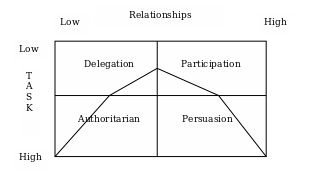
Delegation
This type of leadership implies that a lot of the work is delegated by the leader among his team members. Delegation is essential but care should be taken while doing so to see that the right task is delegated to the right person and that some tasks which have to be done by the leader cannot be delegated.
Participation
This style implies that the leader actively includes the team members in many of the activities of the team. Opinions, suggestions, and new ideas will be welcomed.
Authoritarian
This style which is quite obsolete now implies that the leader takes a dictatorial approach. Such styles were common before system theories began to take root.
Persuasion
This is a soft style of approach that relies a lot on persuasion to get things done.
An Explanation of the grid
The most unproductive style is the delegation style of leadership. The leader does not bother to have participation and simply delegates the job or the responsibility. This will result in low task achievement and poor relationships with employees. The next least desired style of leadership is the authoritarian style. The task is considered more important than people. There will be high delegation without any participation. Such a style may be effective in the short run or sometimes in the case of very small businesses, but is unsuitable in the long run are for more complex organizations. In a participative style, the importance of the task is given low priority and the views and participation of employees are considered to be more important. Such a situation will give rise to healthy relationships with employees, but the low performance of tasks and poor achievement of targets. The most synergistic style would be participative leadership. The leader cares about the job as well as his employees. Principles of modern management like motivation and incentives are involved in this style. This results in excellent relationships with employees and high achievement of tasks.
Effective leadership in Sports-Qits
As mentioned earlier, an authoritative style will never work out in the long run nowadays. Participation of employees is important, especially in the marketing department. It should be noted that IT systems have been installed in the company and a certain amount of fear and uncertainty will exist among the employees. Fear of losing jobs and uncertainty of how they will be able to cope with new technology and responsibilities will be felt by them. A persuasive style can be followed to convince the employees to remain with the company and try out for some time before deciding to leave. Motivation can be used to convince them that they can learn the new technology and new responsibilities as well. Once employees if any have left and the remaining have settled in place comfortably, delegation can begin. This will be the time to exercise a certain amount of authority as well since the discipline has to be maintained. A combination of all styles with a heavy focus on participation and delegation can be adopted. Authority can be used to see that targets are met for both sales and production. It should also be used to keep discipline, especially in the administrative department since they rarely have targets to meet apart from completing regular office work. Persuasion can be used as and when the situation demands.
Communication
Introduction
Sports Qits is a company specializing in replica sports kits since 1990. For the last five years, the sales and profit margin witnessed a downward trend. One of the main reasons was the entry of a competitor with an IT base. Whereas Sports Qits was engaging the postal services for the procurement and implementation of the order, the competitor was utilizing online services for the procurement of the order and servicing the same. The Heads of Finance & Administration, Personnel, Marketing departments had a series of meetings and finally decided to introduce IT-enabled service in the company to counteract the threat forced by the competitor. We will analyze here what are the problems faced by the company is introducing an IT system and how they were solved by effective communication.
The Administration department books the orders, Marketing department prepares leaflets highlighting the quality of the products and the Personnel department recruit the staff and prepare the wage bill. The following problems were identified at the time of planning the IT Project.
Advantages
- Increase in market share.
- Reduce the workload.
Disadvantages
- Lack of technical skill.
- Fear of reduction staff strength.
- High expenses.
IT Project Plan
A plan envisages a consultancy firm to prepare the project report, discuss the report with the employees to remove the apprehension about staff reduction but highlight the benefits of market share and reduce workload. The project report will also contain details about how the increased market share will offset the high expense.
Successful Communication
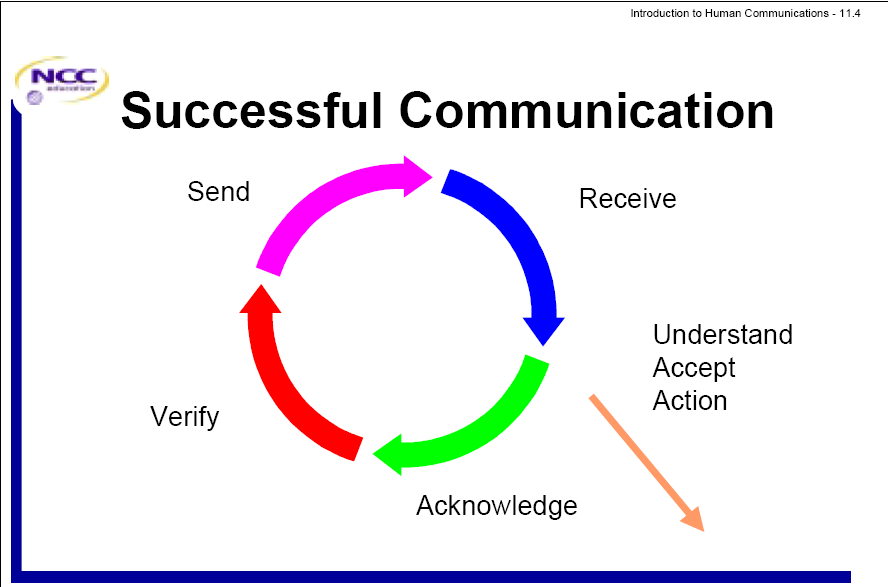
Many problems that are seen in the world today arise out of poor and ineffective communication. Such problems can occur in personal life, business and politics. In most cases, the proper communication process did not exist in the first place. It could also happen that the communication was poorly done or even if the communication was good, it was not grasped by the person to whom it was intended. “Communication is the exchange and flow of information and ideas from one person to another. It involves a sender transmitting an idea to a receiver. Effective communication occurs only if the receiver understands the exact information or idea that the sender intended to transmit.” (Communication and Leadership 2005). When one thinks about communication, the first thing that comes to mind is the spoken or written word.
Communication using speech is more complicated than communication through writing. A very interesting fact of oral communication was introduced to the world by Albert Mehrabian, a professor at U.C.L.A. According to him, there are three elements in oral communication. The spoken word (verbal elements) accounts for only just 7% in effectively communicating the matter. 36% is communicated by vocal elements and 55% through non-verbal elements. Vocal elements include the tone in which the word is spoken, the pitch of the speaker, and the rate or speed at which communication is delivered. Non-verbal elements include the body language (posture, hand gestures, etc) of the speaker. “U.C.L.A. Psychologist and researcher Albert Mehrabian illustrated the impact and importance of non verbal language in his 1967 investigation of how people communicate.” (PATTERSON). The first part of any communication process is to send the message either in person or by letter. The second part is as important as the first namely to receive/listen. The third part is acceptance and action. The fourth part is verification. The sender communicates the message in a code that will be understood by the receiver and the receiver decodes the message in his perspective. The following filters are important in any codifying / decodifying process. They are communication filter, language filter, cultural filter, and experience filter.
Medium
The medium can be verbal – telephone, face to face, teleconference, presentation etc. The written communication can be postal, email, fax, report, manual etc.
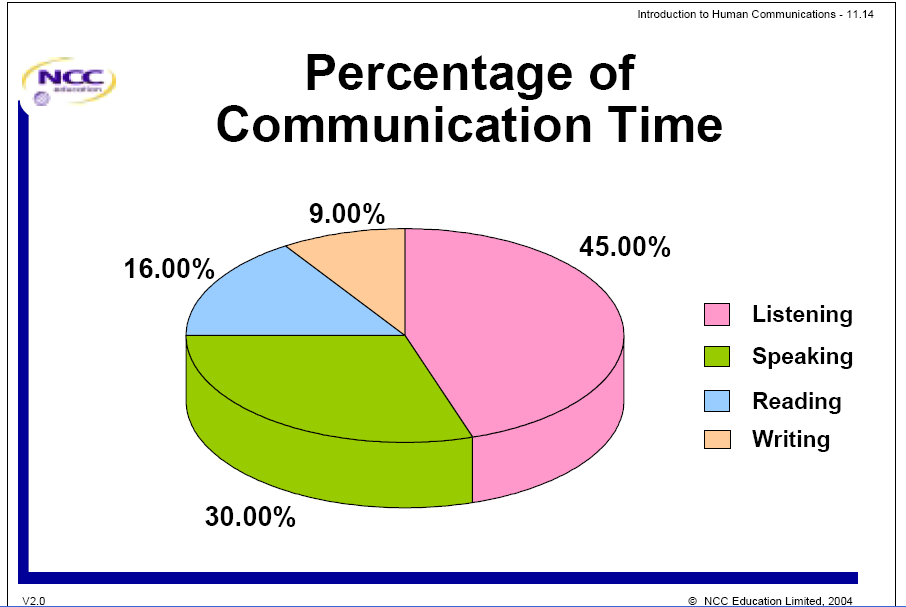
A person will never be a good communicator unless he is a good listener too.
Barriers to Communication
- Assumptions / preconceived misconcepts.
- Inexperience.
- Incompatible objectives.
- Attitude of the sender/ lack of interest.
Crisis in Communication
Must Do: Involve senior management, tell the truth, and demonstrate concern,
Must not Do: Speculate in public, decline to answer, release confidential documents, play favorites.
The five W’s of what, when, why, where and whom are supplemented by how in effective communication.
Mentoring and Coaching
Mentoring and coaching is an inevitable process that a leader must exercise on his followers. The wisdom and experience of the leader is transferred to the follower (employee or subordinate in this instance) so that he may grow as a leader. It is also used to solve personal problems that the follower may face during the performance of his jobs in the organization.
Mentoring Expectation
- Satisfaction.
- Recognition.
- Reward.
Expectation of mentoree
The expectation of your mentoree will vary from situation to situation and from person to person. You must establish what their expectations are at the outset of the mentoring relationship; otherwise you are heading straight for failure.
The advice implies wisdom, insight and superior knowledge. Criticism implies judgment and compliant which leads to low self esteem and defensive blocking. In effective mentoring sufficient care should be taken so that the mentoree feels that he is not criticized but being advised. Careful and effective listening is a part of any successful mentoring.
The special situations encountered during mentoring are Cross gender, Cross cultural, cross hierarchy mentoring. The primary challenges in mentoring are to adapt our workforce to the demographic changes, prepare for a global environment and effectively manage organization and technological changes.
Knowing his limitations is a special skill of the mentor. The mentor does not have a magic wand to solve every problem of the mentoree. Mentor should admit when he is out of depth. The skills of effective communication should be reflected in the mentoring process.
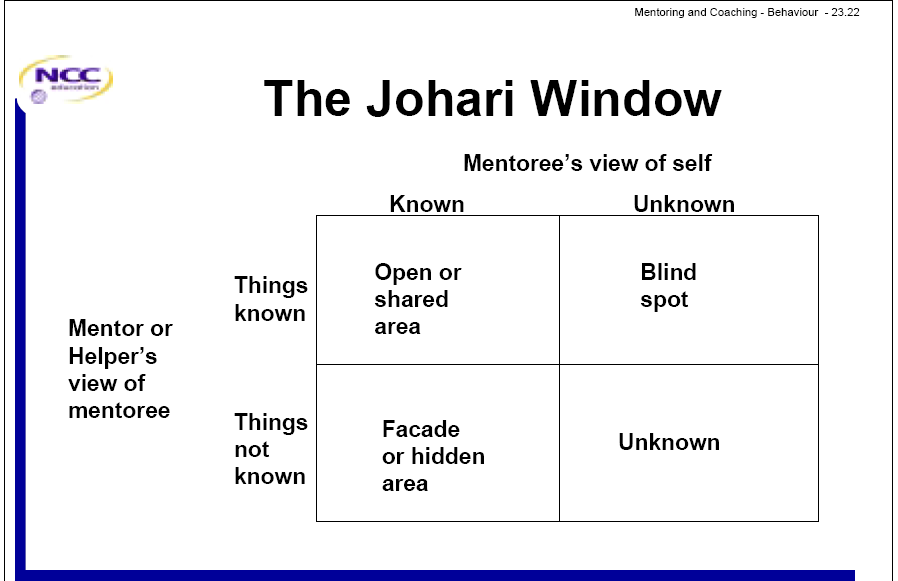
The window is a double matrix of the mentor’s view of the mentoree and the mentoree’s self assessment.
Now we will examine how the above principles of effective communication and mentoring were utilized in the Sports Qits Company while implementing the IT project. The first obstacle faced by the company was to remove the apprehensions among the employees regarding reduction staff strength on implementation of IT project. For this, examples of other companies that have successfully implemented the similar IT project were explained to the employees through seminars with the participation of management experts. It was explained that the higher market share will open up new avenues in marketing and the excess employees due to computerization will be absorbed to cater to the needs of additional sales. The inexperience of the employee was tackled by a good training system. The employees were trained by IT experts who were well versed in online trading. The communication crisis was solved by involvement of the top management who were present in all the seminars and training sessions to explain the necessity of the IT projects to ensure the viability of the organization. Loss talk and speculation were restricted.
Bibliography
CLARK, Donald (2007). Concepts of Leadership. [Online]. Google. Web.
Communication and Leadership. (2005). [Online]. Web.
HP dx2250 RT949UT AMD Desktop Computer. (2008). [online]. COMPUSA.com. Web.
Merriam-Webster’s Online Dictionary: va=Charisma. (2007-2008). [Online]. Merriam-Webster. Web.
PATTERSON, James G. The Power of Non-verbal Communication. Non Verbal Communication. [Online]. Web.
WEEKS Peter (2008). Soft Systems Methodology: (Checkland): Applying Systems Thinking to Non-Systemic situations. Explanation of Soft Systems Methodology of Checkland, (’81): What is the Soft Systems Methodology? Description. [Online]. 12Manage: The Executive Fast Track. Web.